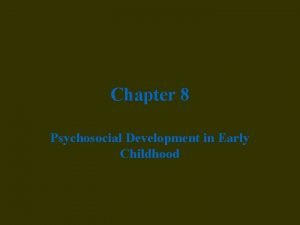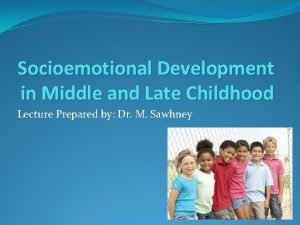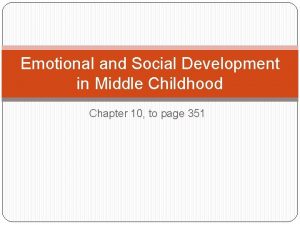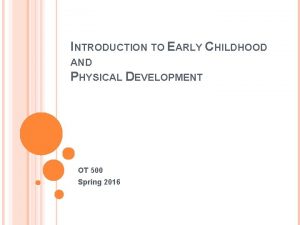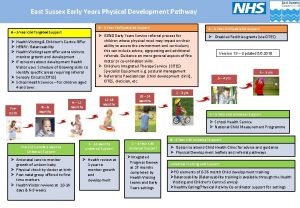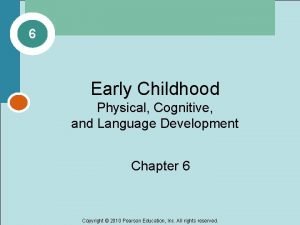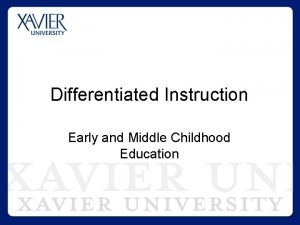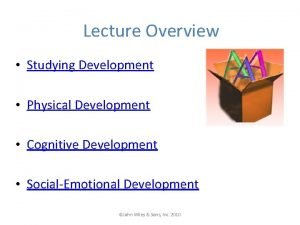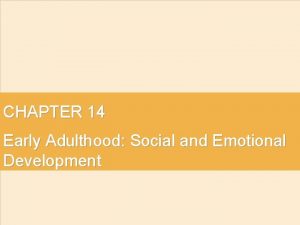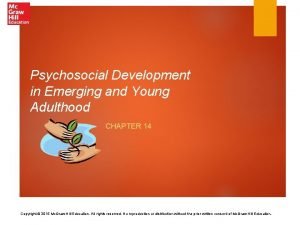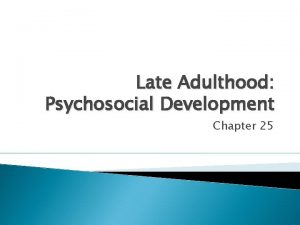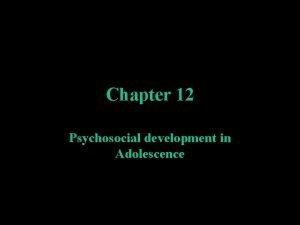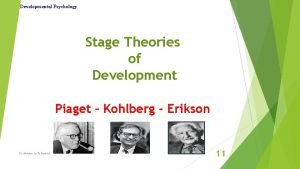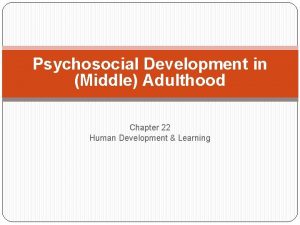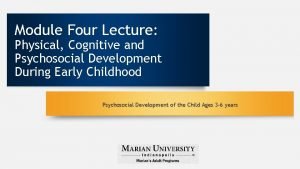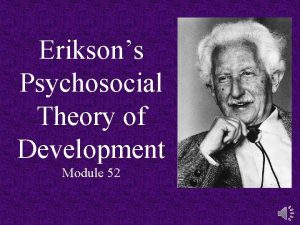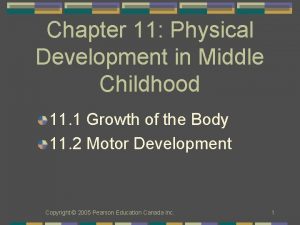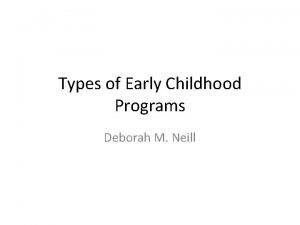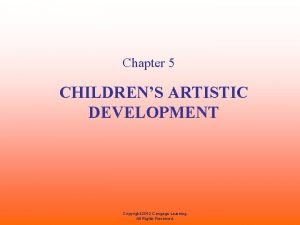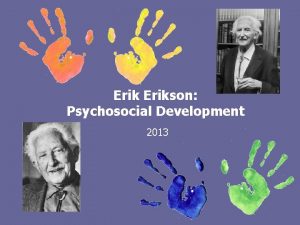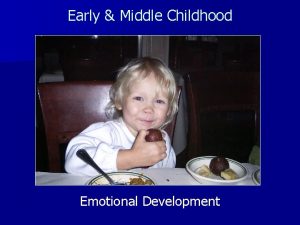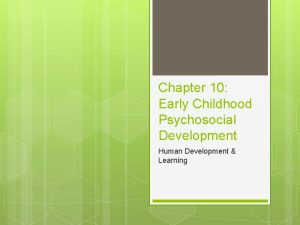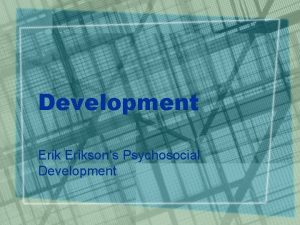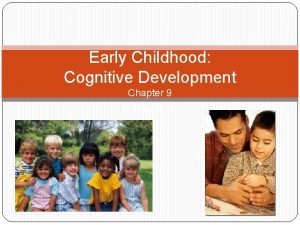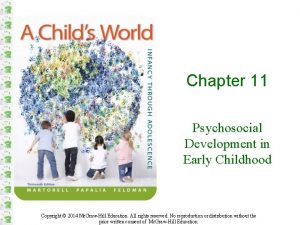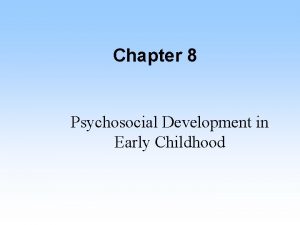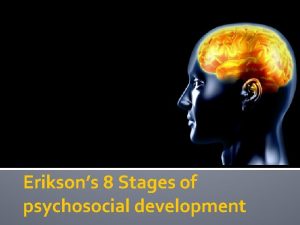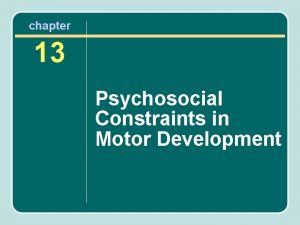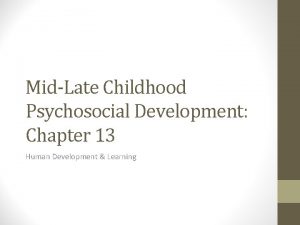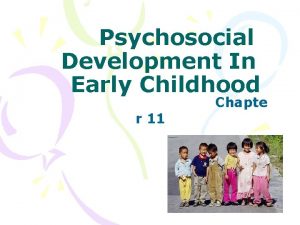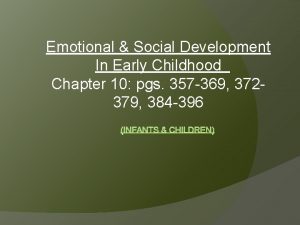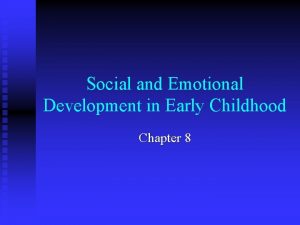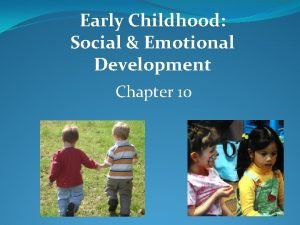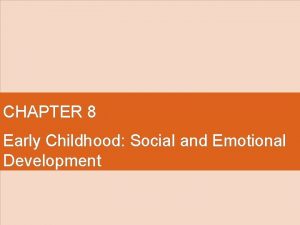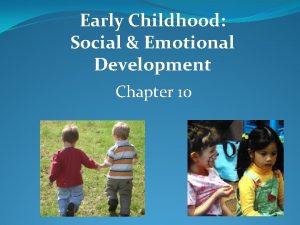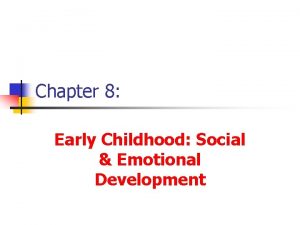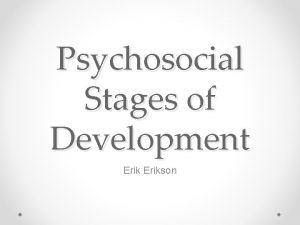Chapter 6 Early Childhood Psychosocial Development Emotional regulation









































- Slides: 41

Chapter 6: Early Childhood: Psychosocial Development • • Emotional regulation Parenting patterns Self-esteem Moral stages of development Psychosocial stages Systems theory Intrinsic/extrinsic motivation Types of aggression Punishment Psychopathology Types of play Sex differences in play

• Emotional Regulation- The ability to control when and how emotions are expressed • Why is emotional regulation so important? • Because learning how to express emotions is very important for functioning in society • Emotional regulation is a psychosocial accomplishment between ages 2 and 6. • Children that can master emotions regulation are able to develop socially and experience feelings of autonomy and higher levels of self-esteem.

Initiative vs Guilt • Initiative vs guilt-Erikson’s 3 rd psychosocial crisis, children undertake new skills/activities and may feel guilty when they do not succeed. • • Children’s self-esteem is very vulnerable during this time, as is selfconcept. Typically the child’s self-esteem may be skewed based on a highly positive perception of his or her own self-concept (they may also view their parents in high regard as well) (they may not see or recognize their faults) • • Self-Esteem- a person’s evaluation of his or her own worth (parents can remind children of past accomplishments) • • Self-concept-a person’s understanding of who he or she is (incorporates self-esteem, physical appearance, personality, and various personality traits such as gender and size) • Protective Optimism: Preschoolers predict that they can solve impossible puzzles, remember long lists of words, and control their dreams. – Helps them try new things

• • As the self-esteem increases and strengthens, children feel more competent to try new activities and meet new challenges • • Having a secure attachment between child and parent can be influential in developing self-esteem…why? • Because the parent is the base, and when there is a secure attachment, the child feels free be independent and exert autonomy, hence, taking the initiative • • As the child strengthens the self-esteem and develops a more accurate self-concept, the child is able to experience guilt when unable to accomplish a task

Guilt and Shame • Guilt: Self-blame that people experience when they do something wrong • Shame: People’s feeling that others blame them, disapprove of them, or are disappointed in them

Motivation • Intrinsic motivation- when people do things for their own gratification • Extrinsic motivation- when people do things for an external reward or reinforcement • How are intrinsic and extrinsic motivation connected to emotional regulation? Children are motivated to control their emotions especially in a social environment • Most preschool children are intrinsically motivated, engaging in activities for the mere joy that the activity provides • Experiment in motivation • 1. No reward • 2. Expected reward • 3. Unexpected reward • • Expected extrinsic motivation for activities that the person enjoys doing, jeopardizes intrinsic motivation

Culture and Motives • Goals for emotional regulation that seem to be important in certain cultures: – Overcome fear (United States) – Modify anger (Puerto Rico) – Temper pride (China) – Control aggression (Japan) – Be patient and cooperative (Native American Communities)

Emotional Balance • • It is healthy to experience moderate levels of shame, guilt, anger, etc. , however, it is important for the child to exhibit emotional regulation, a lack of emotional regulation is considered to be an early sign of psychopathology (an illness of the mind) Emotional regulation is a sign of a maturing prefrontal cortex and is best learned through peer interaction • The child may have externalizing problems (difficulty with emotional regulation that involves expressing powerful feelings through uncontrolled physical or verbal outbursts, by lashing out or breaking things) that may impede the child’s ability to control their emotions (this is usually displaced anger) • At 2 this behavior may be typical as the two year old has not mastered emotional regulation; this behavior should not be typical for a 6 year old • Other children and adults may have internalizing problems (difficulty with emotional regulation that involves turning one’s emotional distress inward, as by feeling excessively guilty, ashamed, or worthless) may result in self-mutilating behaviors such as cutting

• Undercontrolled adolescents may become delinquents and overcontrolled adolescents may become anxious or depressed, these behaviors may also have genetic (maternal stress, illness, heavy drug use) or social (parents, malnourishment injury or fright) influences • The quality of caregiving is important (synchrony, attachment, temperament, personality) in the child’s ability to regulate emotions

Psychopathology What is the relationship between emotional regulation and psychopathology in children? Externalizing problems Internalizing problems • • • turning emotions and distress inward • difficulty with emotional regulation • excessively feeling guilt, shame, worthlessness lashing out at others or breaking things difficulty with emotional regulation expression of powerful feelings uncontrolled physical or verbal outbursts psychopathology: An illness or disorder of the mind. 10

• Lack of emotional regulation may be an early sign of psychopathology • Externalizing problems – Involves expressing powerful feelings through uncontrolled physical or verbal outbursts, as by lashing out at other people or breaking things • Intenalizing problems – Involves turning one’s emotional distress inward, as by feeling excessively guilty, ashamed, or worthless

• Why are children of depressed parents vulnerable to difficulty with emotional regulation? • Studies show that genetically vulnerable children raised by nurturing caregivers have the advantage over the average child in emotional regulation, why? • This is why parenting styles are so important. • Psychopathology is not just the result of temperament or bad caregiving, it is a combination

Sex Differences in Emotional Regulation • Neurological and hormonal effects: – Boys tend to be aggressive (externalizing) – Girls tend to be anxious (internalizing) • Psychopathology is not typical! – Children of both sexes usually learn to regulate their emotions as their brains mature and their parents nurture them

Play • Play is very important because through play with peers, children learn appropriate social norms • It is the most productive and enjoyable activity that children do; play is subjective to gender, culture, ecological context (setting) and age • How has media influenced children’s play? • Children have sexual awareness by age 6 • Play is universal – Archeologists find toys that are many thousands of years old – Anthropologists report play in every part of the world


Types of Play • Solitary play –child plays alone, unaware of any other children playing nearby • Onlooker play-a child watches other children play • Parallel play-children play with similar toys in similar ways, but not together • Associate play-children interact, observing each other and sharing material, but their play is not mutual and reciprocal • Cooperative play-children play together and creating elaborating a joint activity or taking turns • • Active play • rumble and tumble for boys, • sociodramatic play for girls • What are the benefits of sociodramatic play? Explore and rehearse the social roles around them, test their ability to explain and convince others to paly, practice regulating emotions through pretend play, develop a selfconcept in a non-threatening environment

• Age 2: Children know whether they are boys or girls and apply gender labels consistently • Age 4: Children are convinced that certain toys (such as dolls or trucks) are appropriate for one gender but not the other

Piaget • I. Sensorimotor stage • II. Preoperational stage-For Piaget the Preoperational Stage extends from age two to approximately ages six or seven. During this period the child acquires motor skills and develops a sense of self. She/he is capable of imaginative thinking and playful activity. While she/he can focus on discrete information items she/he is not capable of logical, discursive thought. • 1. Imaginative solo play in the sand, construction of imaginary objects using simple plastic equipment • 2. Solo play on playground equipment, particularly not involving complex motor skills such as sliding down a slide. • 3. Not being physically far from caregiver; frequent looking at caregiver (even if caregiver otherwise occupied, e. g. in reading a magazine) for reassurance and approval. • 4. Sitting with caregiver and playing simple games e. g. with hands or string (weaving string webs or mazes).

• III. Concrete operational stage-The Concrete Operational Stage extends from age seven to approximately ages 11 or 12. During this period the child becomes more capable of independently acquiring information about the world and thinking in terms of cause-effect relationships. The child also becomes less egocentric and more aware of the presence of others. Many potential utilizers of Holmby Park probably were in school when I conducted the observation, reducing the sample size for Piaget’s Concrete Operational Stage. Here are some examples I observed of childrens’ behavior in this stage: • 5. Introduction to and play with other children, even if personal identifiers (name, age) not clearly established. • 6. Fantasy role-playing with other children, e. g. “you pretend to be this and I’ll pretend to be that” then typically enacted on playground play equipment. • 7. Greater motor facility demonstrated by playing on more complex playground equipment, e. g. parallel bars. • 8. Progressive gender identification, e. g. girls playing with genderstereotypical objects such as dolls.

Parenting Styles • Parenting is influenced by many factors • Diana Baumrind found that parents differed on four important dimensions • Expression of warmth- some parents are very affectionate, others are cold and critical • Strategies for discipline-punish, explain, ignore, criticize, persuade • Communication-some parents listen patiently to their children, others demand silence • Expectations for maturity-parents vary in the standards they set for their children regarding responsibility and self-control

Parenting Styles What are four basic parenting styles? Authoritarian Authoritative Permissive Neglectful/Uninvolved • Indifference • Unaware of what happens in child’s life • High behavior standards • Sets limits but listens • High nurturance and communication • Strict punishment of misconduct • Flexible • Little discipline, guidance, or control of misconduct • Little communication 21

4 Patterns of Parenting • • • Authoritarian parenting-parents’ word is law, low on warmth, high on discipline Permissive parenting-parents make few demands, very low on discipline, high on warmth Authoritative parenting-high on discipline, high on warmth Neglectful/uninvolved parenting-do not know what the child is doing, nor do they care Implications of parenting style Authoritarian parents raise children who become conscientious, obedient, quiet, but not happy. These children may internalize their problems Permissive parents raise children who lack self-control, especially in relationships. They are immature because they have no emotional regulation. They tend to live at home and are dependent adults. Authoritative parents raise children who are successful, independent, and happy. Although Baumrind’s findings are influential, she does not account for culture, SES, ethnicity, parental attitudes, and daily interactions with parents


Cultural Variations • The value of a systems approach to development is dependent upon ethnic groups. • With discipline, parental attitudes should be taken into consideration; if children believe that the parents love them and appreciate them the children will fare better; if the children feel that they are rejected, discipline may seem more harsh and severe and may have psychological implications, including significance with developing self-esteem • Authoritarian parenting is more common as income falls, because low-income families have more children or parents expect complete obedience • In considering the systems perspective, developmentalists do not recommend any particular parenting style • *Most importantly, parenting styles are important, but children’s behaviors may be a better predictor of behavioral problems (over control, under control) lack of social play

Parenting styles have changed and one reason parenting styles have changed is that new challenges confront each new generation of parents. With the progression of television, parents are able to keep children amused and preoccupied, the typical young child may watch more than three hours a day Too much television watching for children may be harmful to physical development and additional development for children under 6 years of age; the more television children watch, the angrier they become

• As Bandura’s experiments have illustrated, when children are exposed to aggression in violence, especially when viewed in television programs, children may be more affected by the violence than adults • children that watched only educational shows tended to become good students, children who watched television violence became more aggressive; less creative, and lower-achieving

• Electronic media is more prevalent among older children and siblings and because young children tend to follow the family’s example, young children ages 2 -6 years may not experience full learning • Electronic media is not conducive for family engagement and social development • The myth that the media will teach good values is wrong…children learn inappropriate values and may not understand how to separate real from fantasy (violence in cartoons) children are not exposed to opposite gender, ethnic appropriate examples

Moral Development • Kohlberg stages of Moral development • Heinz Steals the Drug • In Europe, a woman was near death from a special kind of cancer. There was one drug that the doctors thought might save her. It was a form of radium that a druggist in the same town had recently discovered. The drug was expensive to make, but the druggist was charging ten times what the drug cost him to make. He paid $200 for the radium and charged $2, 000 for a small dose of the drug. The sick woman's husband, Heinz, went to everyone he knew to borrow the money, but he could only get together about $ 1, 000 which is half of what it cost. He told the druggist that his wife was dying and asked him to sell it cheaper or let him pay later. But the druggist said: "No, I discovered the drug and I'm going to make money from it. " So Heinz got desperate and broke into the man's store to steal the drug-for his wife. Should the husband have done that? (Kohlberg, 1963, p. 19)

Kohlberg stages of Moral development • • • Level I (preconventional) Stage I-Obedience and Punishment orientation (similar to Piaget 1 st stage) –It’s wrong to steal because you’ll get punished Stage 2 -Individualism and Exchange-different individuals have different viewpoints –What’s in it for me? (self-interests) Level II (conventional) Stage 3 -Interpersonal accord and conformity- social norms-people should live up to others’ expectations of the family and community and behave in good wayshe loves his wife, no husband should let his wife die (good boy/g) Stage 4 -Authority and Maintaining Social Order-obeying the law, respecting authority-what would happen if we all started stealing? Cannot condone theft Level III (Post conventional) Stage 5 -Social Contract and Individual Rights-it is a human’s basic right to live and this supersedes the law (moralistic) Stage 6 -Universal Principles-there should not be a law that protects some and hurts others( uphold social contracts and laws that promote a good society)

• The major psychosocial accomplishment of the play years is learning when and how to express emotions (emotional regulation) • During the play years, self-esteem increases and the self-concept is strengthened because of expanding range of skills that the preschooler is mastering initiative vs guilt the child wants to take on new tasks and feels guilty if he or she is criticized or fails • As children mature they develop complex moral values, judgments, and behaviors. In early childhood, children rely on pleasing their parents to determine their moral compass. Children then advance to avoiding punishment. • In adolescence, moral development is dependent upon social factors and what is morally important

• In adulthood, moral development is focused on altruistic factors • In childhood, as children decrease egocentrism, children learn empathy (the understanding of other people’s feelings) and antipathy(dislike or hatred for another person) from socializing with other children. • Empathy leads to prosocial behavior-kindness and helpfulness offered without any obvious benefit • Antipathy can lead to antisocial behaviors • Prosocial behavior increases from ages 3 -6 and antisocial behavior declines around age 2 -Why? Maybe because of social interaction, social norms, gender roles, self-concept

• As children experience brain maturation and socially develop, children are able to control their aggressive tendencies. • There are 4 major types of aggression • Instrumental aggression hurtful behavior that is intended to get something another has • Reactive aggression retaliation for another person’s intentional or accidental action, verbal or physical • Relational aggression non-physical acts such as insults or social rejection, to harm the social connection between victim and other people • Bullying aggression unprovoked repeated physical or verbal attacks, victims are unlikely to protect themselves


• Aggression follows a developmental pattern becoming more hurtful • Secure attachments and close emotional bonds between parent and child are necessary in moral development social norms influence moral values and moms promote social norms • How might parental discipline influence aggression development in children? • Theory of mind ^ prosocial behavior, thinking how someone else would think • Self-concept ^ prosocial behavior, sharing, helping • Fast-Mapping makes discipline difficult because children are talking, but lack the comprehension for expression of motives (why did you do that? ) • • Because children are not logical, children between ages 2 -6 years are more harshly disciplined “ • Physical punishment increases obedience temporarily, especially when children are small (ethnotheories) • Other forms of punishment may be psychological control may undermine children’s self-esteem, time-out, and time-in…keep conversations brief

DSM-IV-TR • Cluster A (odd or eccentric disorders) • Not to be confused with Type A personality. • Paranoid personality disorder: characterized by irrational suspicions and mistrust of others. • Schizoid personality disorder: lack of interest in social relationships, seeing no point in sharing time with others, anhedonia, introspection. • Schizotypal personality disorder: characterized by odd behavior or thinking.

• • • Cluster B (dramatic, emotional or erratic disorders) Not to be confused with Type B personality. Antisocial personality disorder: a pervasive disregard for the rights of others, lack of empathy, and (generally) a pattern of regular criminal activity. Borderline personality disorder: extreme "black and white" thinking, instability in relationships, self-image, identity and behavior often leading to self-harm and impulsivity. Histrionic personality disorder: pervasive attention seeking behavior including inappropriately seductive behavior and shallow or exaggerated emotions. Narcissistic personality disorder: a pervasive pattern of grandiosity, need for admiration, and a lack of empathy. Characterized by selfimportance, preoccupations with fantasies, belief that they are special, including a sense of entitlement and a need for excessive admiration, and extreme levels of jealousy and arrogance. • • Cluster C (anxious or fearful disorders) Avoidant personality disorder: pervasive feelings of social inhibition and social inadequacy, extreme sensitivity to negative evaluation and avoidance of social interaction. Dependent personality disorder: pervasive psychological dependence on other people. Obsessive-compulsive personality disorder (not the same as obsessivecompulsive disorder): characterized by rigid conformity to rules, moral codes and excessive orderliness. Appendix B: Criteria Sets and Axes Provided for Further Study Appendix B contains the following disorders. [15] Depressive personality disorder – is a pervasive pattern of depressive cognitions and behaviors beginning by early adulthood. Passive-aggressive (negativistic) personality disorder – is a pattern of negative attitudes and passive resistance in interpersonal situations.

Discipline and Children’s Thinking 1. Remember theory of mind. Young children gradually come to understand things from other viewpoints. 2. Remember emerging self-concept. When the sense of self is developing, sharing becomes more difficult. 3. Remember fast-mapping. Young children are eager to talk and think, but they say more than they really understand. Explanations and discussion before and after misbehavior help children learn. 4. Remember that young children are not logical. Children may disconnect a misdeed from the punishment.

Other Forms of Punishment • Psychological control: A disciplinary technique that involves threatening to withdraw love and support and that relies on a child’s feelings of guilt and gratitude to the parents. • Time-out: A disciplinary technique in which a child is separated from other people and activities for a specified time.

Sex and Gender • Sex differences: Biological differences between males and females, in organs, hormones, and body shape. • Gender differences: Differences in the roles and behaviors that are prescribed by a culture for males and females. – – Initial confusion about gender and sex Age 5: Increased awareness of sex and gender differences Age 8: Belief that their biological sex is a permanent trait Increase of awareness of sex differences, preferences for samesex playmates and stereotypical gender activities from age 2 to age 8

Theories of Gender Differences Behaviorism • Gender differences are the product of ongoing reinforcement and punishment – "Gender-appropriate" is rewarded more frequently than "gender-inappropriate" behavior • Social learning theory: Children notice the ways men and women behave and internalize the standards they observe

Cognitive theory • Gender schema: A child’s cognitive concept or general belief about sex differences, which is based on his or her observations and experiences. – Young children categorize themselves and everyone else as either male or female, and then they think and behave accordingly. • Systems theory • Offers the most complex and comprehensive explanations for gender differences. – Genes and culture, parents and peers, ideas and customs all interact, affecting each child
 Psychosocial development in early childhood
Psychosocial development in early childhood Middle adulthood physical development
Middle adulthood physical development Middle childhood years
Middle childhood years Early childhood is __________ for language learning
Early childhood is __________ for language learning Socio-emotional development of late childhood
Socio-emotional development of late childhood Middle childhood emotional development
Middle childhood emotional development Fine motor skills development in early childhood
Fine motor skills development in early childhood Physical development in early childhood
Physical development in early childhood Language development in early childhood
Language development in early childhood Biosocial development in early childhood
Biosocial development in early childhood Ldoe delivery recipes
Ldoe delivery recipes Development
Development Social development early adulthood
Social development early adulthood Types of early childhood programs activity a chapter 2
Types of early childhood programs activity a chapter 2 Chapter 7 early childhood ages 3 through 5
Chapter 7 early childhood ages 3 through 5 Stages of psychosocial development
Stages of psychosocial development Chapter 7 human growth and development
Chapter 7 human growth and development Emerging adulthood psychosocial development
Emerging adulthood psychosocial development Late adulthood psychosocial development
Late adulthood psychosocial development Trust vs mistrust example
Trust vs mistrust example Intiative vs guilt
Intiative vs guilt Psychosocial development in adolescence
Psychosocial development in adolescence Erickson's psychosocial theory of development
Erickson's psychosocial theory of development Erikson's psychosocial theory of development
Erikson's psychosocial theory of development Permaparenting
Permaparenting Define physical cognitive and psychosocial development
Define physical cognitive and psychosocial development Trust vs mistrust
Trust vs mistrust What is emotional regulation
What is emotional regulation Late childhood
Late childhood Chapter 10:4 confusion and disorientation in the elderly
Chapter 10:4 confusion and disorientation in the elderly Physical development in middle childhood chapter 11
Physical development in middle childhood chapter 11 Types of early childhood programs
Types of early childhood programs Efq examples of practice
Efq examples of practice Efq
Efq Professional development program rockefeller college
Professional development program rockefeller college Welcome dear parents
Welcome dear parents Nsw department of education
Nsw department of education Leonardo da vinci's childhood
Leonardo da vinci's childhood Trends in early childhood education
Trends in early childhood education Early childhood research quarterly author guidelines
Early childhood research quarterly author guidelines Early childhood ireland garda vetting
Early childhood ireland garda vetting Kerlavage stages of artistic development
Kerlavage stages of artistic development
